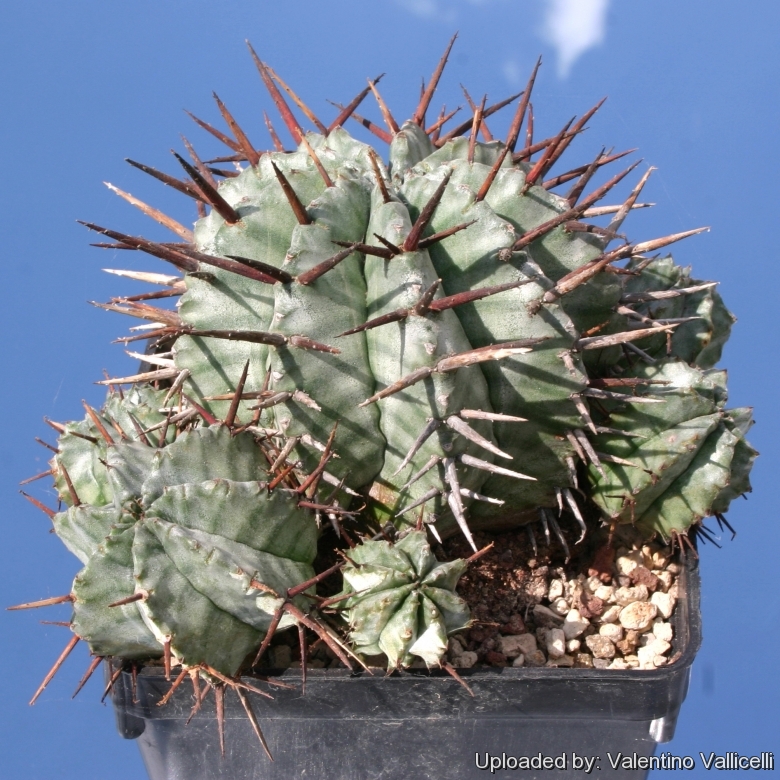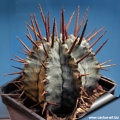
Euphorbia horrida Photo by: Valentino Vallicelli
It is a wonderful example of convergent evolution in fact it resemble incredibly to some new world cacti. The species name 'horrida' comes from the Latin for spiny referring to the formidable rows of spines up to 40 mm long. If the spines weren't deterrent enough, they have also a poisonous, corrosive sap.
Origin and Habitat: South Africa (lower Great Karoo) Found in the Wittepoort Mts. in the Willowmore District, var. striata is found 24 km north of Steyterville, var. noorsveldensis is found 18 km to the north of Jansenville, var. major is found 30 km north of Willowmore.
Ecology: In the eastern Cape region Euphorbia horridaSN|21536]]SN|13381]] and Euphorbia polygonaSN|13381]]SN|21536]] host the parasitic plant Viscum minimum.
Synonyms:
See all synonyms of Euphorbia horrida
Common Names include:
ENGLISH: African Milk Barrel, African Milk Bush
AFRIKAANS (Afrikaans): Noors
RUSSIAN (Русский): Молочай ощетиненный
Description: Euphorbia horridaSN|21536]]SN|13381]] is a spiny succulent shrub with irregular basally clumping stems. In age it will forms tight clumps of upright columns up to a metre wide that closely resemble some cactus species. It also has clustered crowns of somewhat ferocious spines much like the true cacti.
Stem: 100 to 150 mm thick, up to 75 (150) cm tall, erect, cylindrical, blue-grey to grey-green and often with white stripes.
Ribs: 10 to 20, wing-like, prominent, deeply grooved between and more or less undulated
Spines: On the ribs there are 1-5 persistent peduncles, spiny and crowded together about 4-10 mm long and 1-4 formidable main spines up to 40 mm long and very rigid.
Leaves: Inconspicuous and ephemeral in the centre of the plant.
Peduncles: Solitary 4-8 mm tall, hairy with small bracts.
Flowers: Very small green-yellow solitary cyathia approx 4 mm in diameter. Involucre finely hairy with 5 glands and 5 large lobes. Pistil three-lobed. Involucres glands are green, blooms in summer.
Remarks: This plant is somewhat variable with many varieties and forms, and perhaps natural hybrids between it and taller Euphorbias, giving rise to the big, spiny forms like Euphorbia horridaSN|13381]]SN|13381]] var. noorvalescens, furthermore there are several other similar Euphorbia species (particularly Euphorbia polygonaSN|13381]]SN|21536]]) which often looks a lot like some of the forms. Euphorbia horridaSN|21536]]SN|13381]] and Euphorbia polygona are hard to tell apart only by body characteristics, at least when the plants are young. The only certain characteristic is in their cyathia. Euphorbia horridaSN|13381]]SN|13381]] bears green cyathia that sometimes may turn brownish with the age. The cyathia of Euphorbia polygonaSN|13381]]SN|21536]] are red to deep purple.
Parasite: E. horrida is the suitable host plant for the charming parasite Viscum minimum (mistletoe). A minute monoecious, parasitic plant that grows profusely within the stem of the host. Viscum minimum is one of the few types of mistletoe that is ever cultivated outside of its native land. It doesn’t cause significant harm to its host plant, and will produce crops of colourful fruit in time for the holidays year after year.
Subspecies, varieties, forms and cultivars of plants belonging to the Euphorbia horrida group
Notes: Euphorbia horridaSN|13381]]SN|13381]] is a wonderful example of convergent evolution. In fact it incredibly resembles a spiny cactus.
Bibliography: Major references and further lectures
1) Urs Eggli "Illustrated Handbook of Succulent Plants: Dicotyledons" Springer, 2002
2) John Manning, Colin Paterson-Jones "Southern African Wild Flowers: Jewels of the Veld" Struik, 2004
3) Hermann Jacobsen "A handbook of succulent plants: Abromeitiella to Euphorbia" Blandford Press, 1960
4) David Rogers "Southern Africa" Struik, 2006
5) Alain Campbell White, Robert Allen Dyer, Boyd L. Sloane "The succelent Euphorbisae (southern Africa)" Abbey garden press, 1941
6) Maurizio Sajeva, Mariangela Costanzo "Succulents 2" Timber Press, 15/mar/2000
7) EUPHORBIA horrida Boiss. [family EUPHORBIACEAE] in: "Flora Capensis", Vol 5 Part 2, page 216 (1925) Author: (By N. E. BROWN, J. HUTCHINSON and D. PRAIN.)
 Euphorbia horrida Photo by: Valentino Vallicelli
Euphorbia horrida Photo by: Valentino Vallicelli Euphorbia horrida Photo by: Valentino Vallicelli
Euphorbia horrida Photo by: Valentino Vallicelli Euphorbia horrida Photo by: Cactus Art
Euphorbia horrida Photo by: Cactus Art Euphorbia horrida Photo by: Valentino Vallicelli
Euphorbia horrida Photo by: Valentino Vallicelli The rounder and whiter forms are often very pretty and appreciated by collectors. Photo by: Cactus Art
The rounder and whiter forms are often very pretty and appreciated by collectors. Photo by: Cactus Art Euphorbia horrida Photo by: Cactus Art
Euphorbia horrida Photo by: Cactus Art Euphorbia horrida Photo by: Valentino Vallicelli
Euphorbia horrida Photo by: Valentino VallicelliSend a photo of this plant.The gallery now contains thousands of pictures, however it is possible to do even more. We are, of course, seeking photos of species not yet shown in the gallery but not only that, we are also looking for better pictures than those already present.
Read More... Cultivation and Propagation: It is a pretty easy species, it grow well in a very draining mineral potting substrate but it isn't picky about soil, the area where this plant is native receives rains in both winter and summer, so it can be watered moderately all year around (except in the coldest month of the winter as it rot easily especially if over wet ) During the summer, they enjoy average feeding and watering. Mature healthy plants are tough and can also be grown out of where frost is not too severe , it can tolerate temperatures down -4°C (-10° C if the roots are kept dry). It like Light shade to full sun, but different clones vary in their tolerance of full sunshine. The general rule is that the smaller and rounder the variety, the less it can tolerate full sunshine.
Propagation: It is propagated from seed sown during spring or summer. Germination occurs within 3 weeks but it can be reproduced by cuttings (The larger forms tend to branch enthusiastically and offsets are readily available) if you remove an offset, remember to let it dry for a week or so, letting the wound heal (cutting planted to soon easily rot before they can grow roots). It is better to wash the cut to remove the latex.
Flowering can be achieved within 5-8 years.
Warning: As with all other Euphorbias when a plant get damaged it exudes a thick white milky sap known as latex. This latex is poisonous and may irritate skin, and pay extreme attention not to get any in your eyes or mouth. Cultivated plants must be handled carefully.
Your Photos

by Cactus Art

by Cactus Art

by Valentino Vallicelli





















